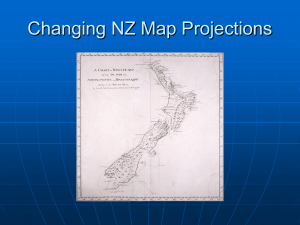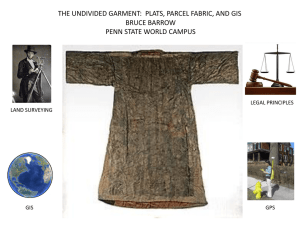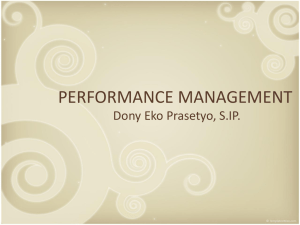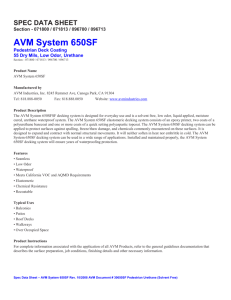Myers - Mass Appraisal Modeling Using GIS
advertisement
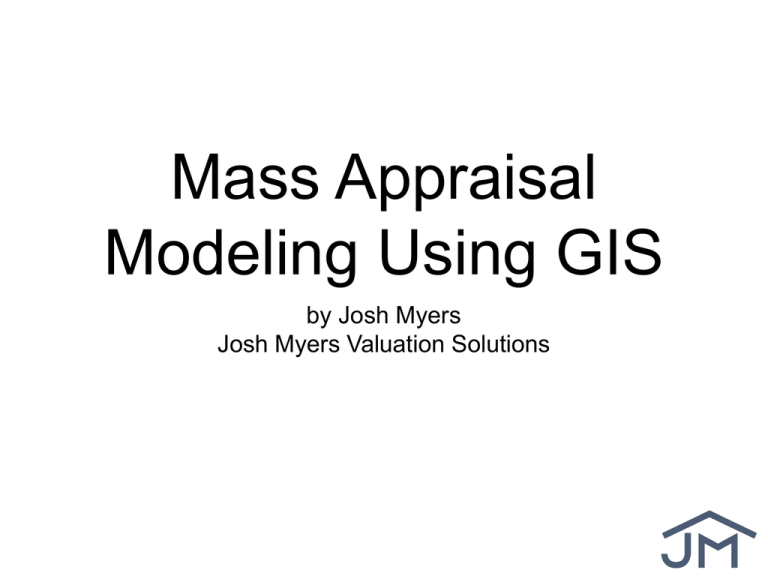
Mass Appraisal Modeling Using GIS by Josh Myers Josh Myers Valuation Solutions About Josh • Josh Myers is president of Josh Myers Valuation Solutions LLC. In addition to consulting, Josh has experience working at the local jurisdiction level and at the CAMA software vendor level. He holds a Masters Degree in Statistics from the University of Virginia. Josh has given about twenty major conference presentations. His article, co-authored with Wayne Moore, PH.D, "Using Geographic-Attribute Weighted Regression for CAMA Modeling," was published in the Journal of Property Tax Assessment and Administration in 2010 and won the 2011 IAAO Bernard L. Barnard Outstanding Technical Essay Award. Josh is also a member of the IPTI/IAAO Editorial Review Board. He resides in Chesapeake, Va., is a volunteer staff member at his Church, and helps coach a high school baseball General Notes • • • The goal today is education through less formulas and more concepts. Feel free to raise your hand and ask short questions as we go along. During the question and answer period at the end, feel free to ask me a question about any topic that you wish, whether we cover it today or not. The Importance of Software • • • Software is the key to changing the mass appraisal industry. This is because people will not implement good ideas until it is feasible to do so; only software grants them that power. Unless good ideas are included in software in an easy-to-use way, then they will never get adopted by the industry at large. We can present on them at conferences, publish papers about them, and place them in the standards, but none of that matters if they aren’t included in software. To AVM or not to AVM? • • What are the benefits and drawbacks of using a Statistical Mass Appraisal Model (AVM) instead of a More “Manual” Approach? (Remember, the marketadjusted cost approach is only partially manual). Here are a few things to consider. First, models make mistakes just as humans do, so they are not infallible. Second, people love to have the perception of control, even if the results are not optimal. To AVM or not to AVM? • • Pros of the AVM: has the potential to be highly accurate; usually results in huge time savings; usually removes many of the problems resulting from human biases. Cons of the AVM: can be hard to explain to appraisers and/or taxpayers; can produce some wildly-incorrect estimates; results are only as good as the modeler. • To AVM or not to AVM? The Cons of the AVM are greatly exasperated when they are implemented improperly or without the sufficient involvement of the appraisal staff. • • • A knowledgable modeler is needed to create and manage the AVM. Staff should be trained in how to understand the AVM and their key role in the process should be clearly explained. After the AVM has been run, results should be reviewed by appraisal staff to check for wildlyincorrect estimates. Using Subjective Factors in Modeling • • • Quality appraisers are critical to the application of subjective factors to real property. In modeling, subjective factors are usually qualitative variables and often times have to be converted to a set of binary variables or linearized as a continuous variable. It is important to have consistent applications of subjective factors in your offices because they can lessen the effectiveness of any mass appraisal model, especially AVMs. How do I Tell which • Model is Better? Usually, people only compare CODs of competing models to see which is better, but does this make sense? • No, for several reasons: • • • • Model coefficient values should be compared to see if they are equally interpretable. A statistical test for the equality of the CODs is needed to tell if the CODs are statistically significantly different. A more detailed comparison of the different types of inequity in the competing models must be undertaken. There needs to be analysis to see how equitably • How do I Tell which Model is Better? Additionally a separate set of sales (prediction sales set) needs to be established to use to accurately compare competing models apart from using the sales used in the modeling (model-building sales set). • • It is important to compare model results under realistic conditions, namely, the forward prediction of sale prices, because that is what we do in mass appraisal. It is important to compare models using the exact same conditions (same model-building sales set, same prediction sales set, and same rules). Use of Location in Modeling • • It is highly important for accuracy to incorporate location into Mass Appraisal Models. This is important for all types of models. Remember, location, location, location! Example: Charlottesville, Va. vs. Chesapeake, Va. How does a mass appraisal model use GIS? • Mass Appraisal Models use GIS through parcel centroid coordinates. • • • • Each parcel in GIS is a polygon. Centroid coordinates are simply the middle point in the polygon of the parcel. Accurate centroid coordinates can be determined from any polygon in GIS, even ones that are not rectangular. Example: (x,y) Two Concepts in Spatial Modeling • Spatial Autocorrelation - the spatial clustering of similar sale prices. • • Simple Example: The houses beside the mall sell for around $200,000, but the houses beside the park sell for around $300,000. Spatial Heterogeneity - the spatial clustering of similar market rates. • Simple Example: The houses beside the river go for about $150 per square foot, but the houses downtown go for about $75 per square foot. Two Types of GIS Mass Appraisal Models • We can’t cover everything today, but I wanted to show you two of the best mass appraisal models out there that use GIS. • • MRA + Comparable Sales GWR/GAWR • • • MRA + Comp Sales Multiple Regression Analysis (MRA) is used here to arrive at the adjustments made in the comparable sales approach. GIS coordinates are used to determine the distance between the subject property and the comparable sale properties, and this distance is used to determine the weight the individual comparable sales have in the determination of the value estimate for the subject. After some math the relationship reduces to the following: Estimate = MRAs + w1*r1 + w2*r2 + w3*r3 + w4*r4 + w5*r5, where MRAs is the MRA estimate of the subject property, w1 through w5 are the set of weights determined by the distance, w1 + w2 + w3 + w4 + w5 = 1, and r1 through r5 are the MRA residuals for the five comparable GWR/GAWR • GWR essentially runs one separate weighted MRA model for every subject property, with the weighting done by geographic distance. Sale properties nearer to a given subject property are given more weight in each regression than those farther away. • GAWR is the same as GWR but with the weighting done by both geographic distance and attribute similarity. Now sale properties nearer and more similar to a given subject property are given more weight in each regression than those farther away and more dissimilar. GAWR • • • A more in-depth presentation of GAWR is available on my website. On the next slide, we see GAWR performing best in comparison to a host of other models, produced by both practitioners and academics, using the large Fairfax County, Va. Test Dataset. One Caveat: no model performs best in every dataset 100% of the time, so different models must be tested and compared with each set of data. GAWR Wait a second... • • You may be thinking, “wait a second, there are other ways to use location in modeling like neighborhoods, market areas, or sub-market areas - what makes you so sure that GIS coordinates are better? Is it really worth making things this complicated?” Let’s investigate this further. • • • The Importance of Coordinates in Modeling Do GIS parcel coordinates add any locational explanatory power over simply having locational binary variables (like the neighborhood, sub-market, or market area for the parcel)? Wayne Moore and Josh Myers did a research project on this in 2010. In short, the project compared the results of several top modelers, with only neighborhood binary variables used to account for location, to GWR and GAWR models, with parcel coordinates used to account for location. Here are some results from that research. The Importance of Coordinates in Modeling The Importance of Coordinates in Modeling • • The Importance of Coordinates in Modeling First, as an aside, the project was able to conclude that there were statistically significant differences among AVM methodologies. Therefore, it is false to believe the choice between models does not matter. In addition, results of the project actually conclude that the GAWR model, using attribute weighting in addition to distance weighting, is a statistically significantly better model than all of the models without parcel coordinates. The GWR model barely misses this distinction, so technically parcel coordinates alone were not proven, with this dataset, to be statistically significantly able to improve performance. • • The Importance of Coordinates in Modeling However, the test that we used was not as powerful as the one I now use for my solo work. With that more powerful test, GWR would have been statistically significantly able to improve performance, meaning that the addition of parcel coordinates could be said to improve performance. Bolstering the case for the efficacy of GAWR, these results also show that GAWR, with or without using the RCN, is the statistically best model when compared to a host of others (although not statistically significantly better, under our original test, than GWR). • • • • Summary We first discussed some general topics: the importance of software, the pros and cons of AVMs, the use of subjective factors in modeling, and how to tell if one model is superior to another. Next we discussed why location is important in modeling, the fact that parcel centroid coordinates are the part of GIS that is used in modeling, and some key spatial modeling concepts like spatial autocorrelation and spatial heterogeneity. Next, two types of mass appraisal models that use GIS coordinates were discussed: MRA + Comp Sales and GWR/GAWR. Promising results were given from GAWR. Finally, additional GWR/GAWR results were used to show the importance of using coordinates over locational market Thank You For Attending! • • We have time for questions. Ask me anything - it can be related or unrelated to something we said today. Go to my website: www.joshmyersvaluationsolutions.com to get a PDF copy of this presentation. This web address is also available on my business card (available up front).
